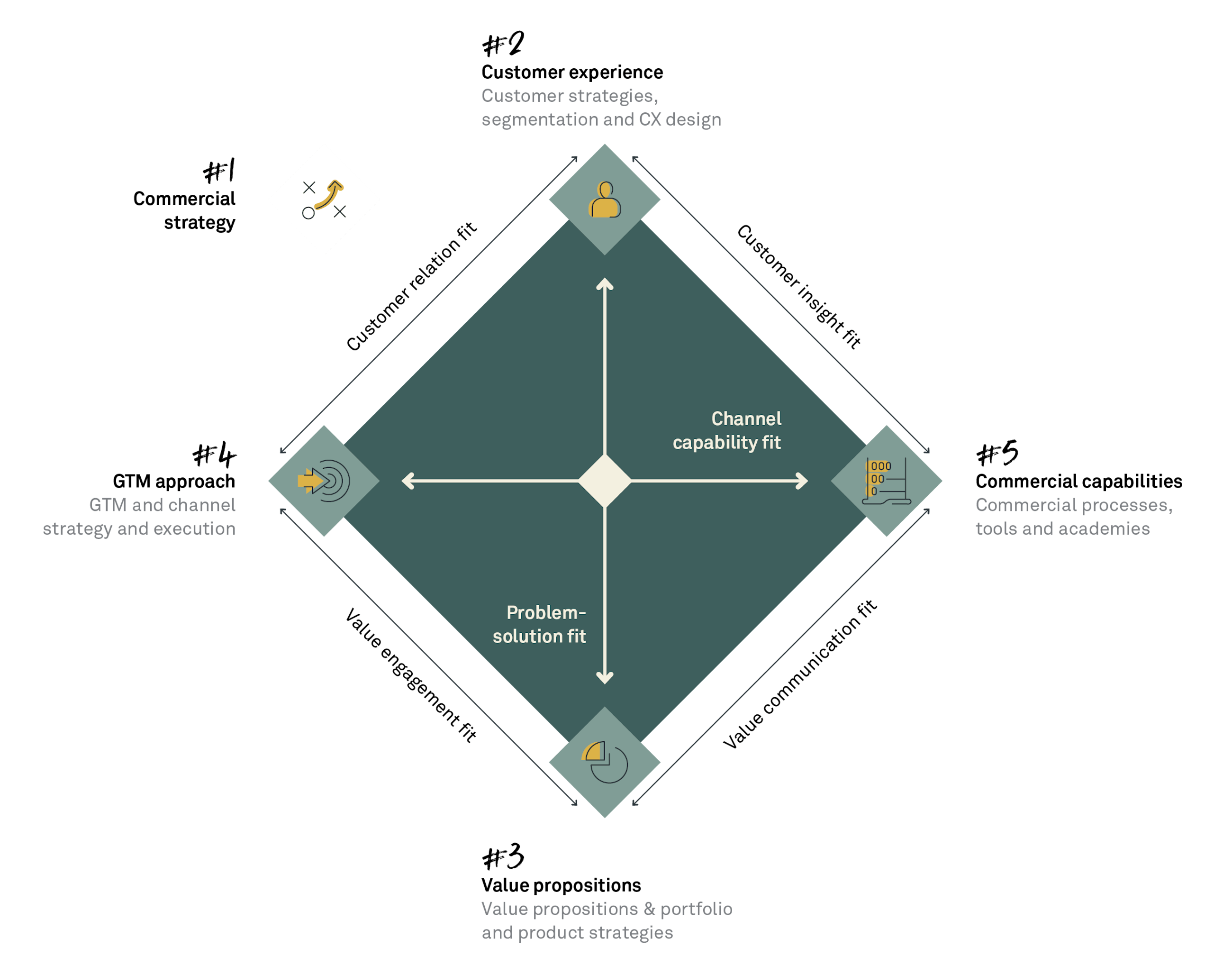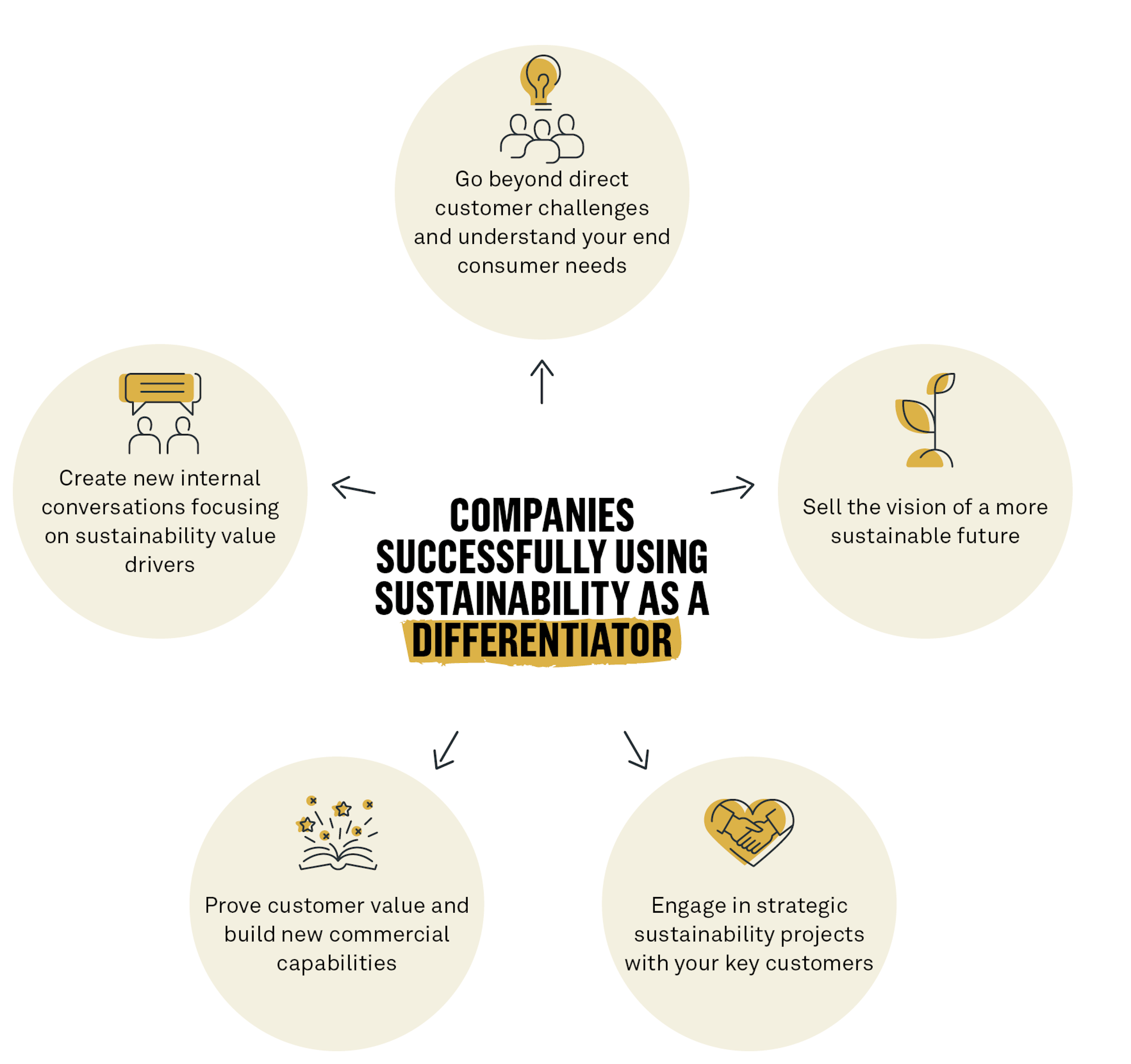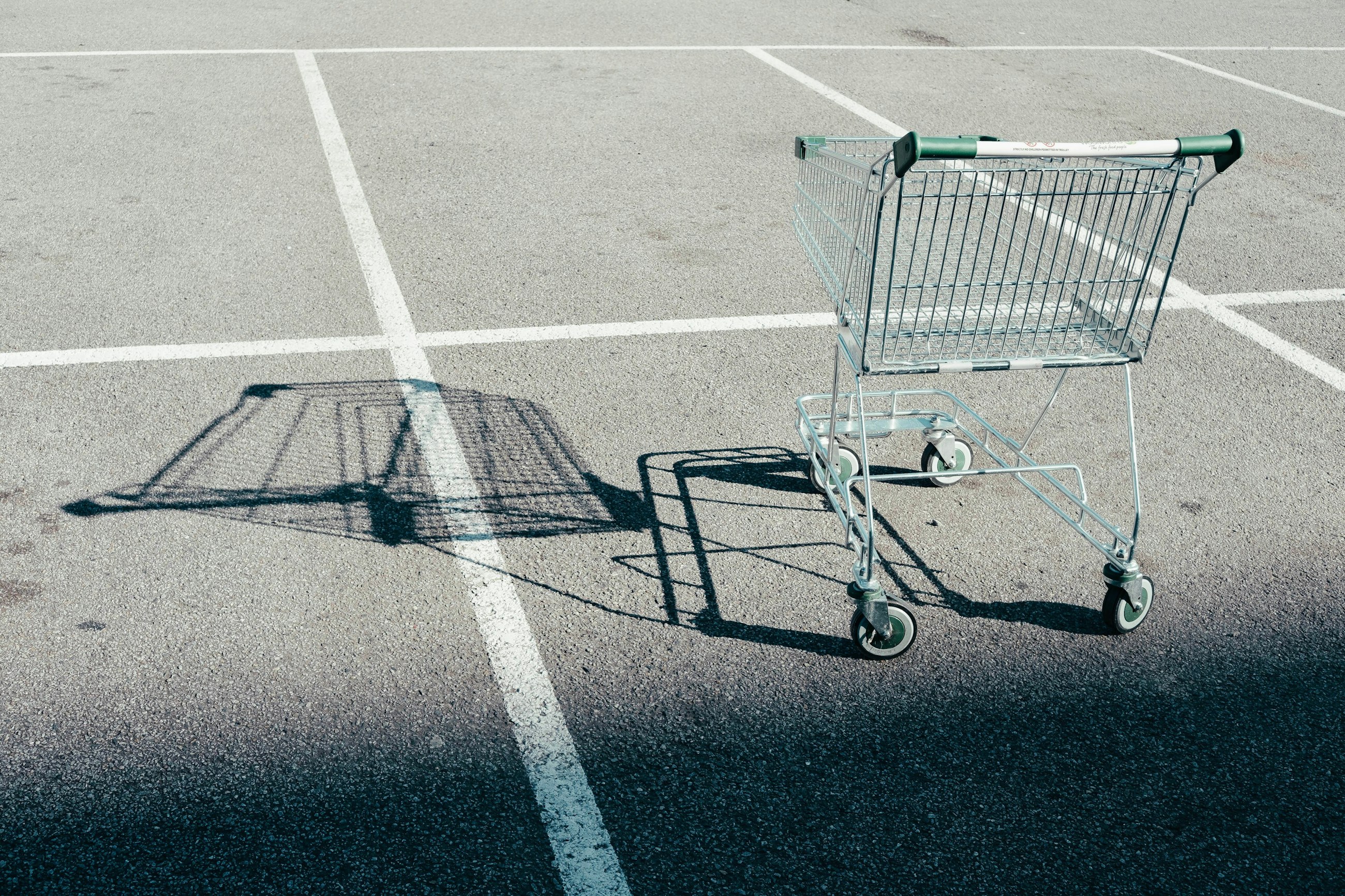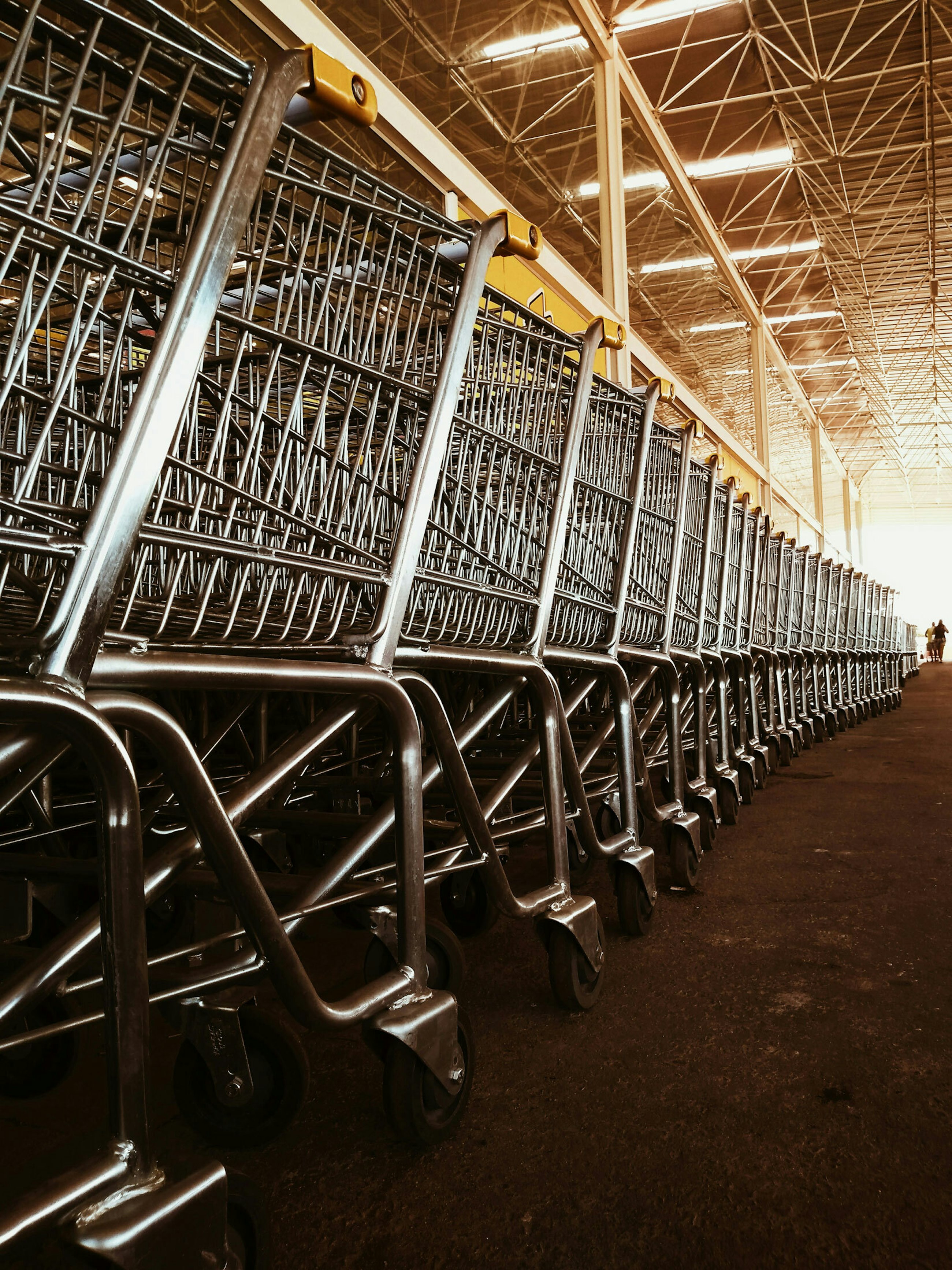Article
Published
14 January 2022
Answering to changing customer behaviour, regulations and increasing awareness, many B2B organisations need to accelerate the translation of their sustainability efforts into a compelling value message and enabling growth. Winning in this field, you need a sustainable commercial strategy.
Many companies have accelerated their transformation towards a more sustainable future, often initiated based on external pressures in changing customer behaviour, regulations and increasing awareness. The sustainable initiatives span all areas of business from innovation and product design to sourcing and operations. Most frequently with the primary goal of measuring and decreasing the total environmental footprint but also to reduce climate and social-related risks. Many initiatives are also driven by the need to comply with stricter reporting standards and requirements, especially for larger corporations.
For sure, we need a continuous acceleration of sustainability efforts. However, we also know that there is a great opportunity in taking the step from playing defence to winning in the offence. Winning in a way that enables growth based on sustainable value drivers and superior sustainability performance embedded into the brand promise.
Several high-performing B2C companies have taken great strides in transforming their value propositions and go-to-market approaches to support their transformation towards a more sustainable portfolio. B2B companies still have a way to go.
Some of the reasons might be that B2B companies are tackling complexities in their value chain dynamics, as for example raw material innovation needs, and experience an increased cost related to sustainable solutions. Enabling B2B organisations to translate their sustainability efforts into a compelling value message and enable growth, a sustainable commercial strategy is needed.
Rethinking the commercial choices
To establish a strong commercial strategy, you must connect the market and customer segmentation, value proposition, go-to-market approach and commercial capabilities.
Figure 1: The growth diamond: A series of inter-elated choices to accelerate sustainable growth.
Therefore, designing a strong value proposition around sustainability is not only a question about communication but also about making choices in terms of which customers to focus on, through which channels to reach the customers with which value messages and also about critical capabilities needed to communicate and deliver on the value proposition.
Characteristics of companies who successfully use sustainability as a differentiator
We have compiled a list of the key characteristics of companies that have successfully commercialised their sustainability efforts:
1. Go beyond direct customer challenges – understanding the end consumer needs
To design and develop a sustainable value proposition, you need to go beyond the direct customers’ immediate needs and understand in depth the impact of emerging trends on the end users of the product. It is in the actual application of the product that the value is created and a reduction in the climate footprint is shown. High performers are curious to understand customers across the entire customer journey and continuously collect and discuss customer trends and insights. Not only in commercial capabilities but across the organisation, creating a customer-centric culture where the needs of their customers in terms of sustainability are key.
2. Sell the vision of a more sustainable future
Moving towards a more sustainable application or version of a product often requires a changed behaviour. Acknowledging the reason for a change needs to be connected to a larger purpose, a vision of a more sustainable future and the role you take in that vision. The value message connected to sustainable solutions should in addition to resonating with the immediate need also relate to the larger purpose connected to the solution and the brand. Enabling this, high-performing companies understand their customers’ business models and are able to describe which elements that are influenced by the changing conditions in strengthened sustainability ambitions.
3. Engage in strategic sustainability projects with your key customers
Take and share risk with your most prioritised customers to drive the development of your collective ecosystem and cross-necessary bridges. High performers have made it an ambition for their largest accounts to engage in joint strategic sustainability projects. Knowing that by engaging in a joint promise will provide them with strong competitive advantage and significantly minimise the risk of churn. Strategic initiatives could imply a disruption in the value chain, joint development of a new offering, initiating new partnerships to broaden the value given to customers etc.
4. Prove customer value and build new commercial capabilities
Companies which are able to differentiate on sustainability are not always the front-runners when it comes to the classical sustainability metrics – but their commercial organisation is able to prove the value to their customers of the sustainability efforts they have made. They prove the value for their customers in terms of a stronger end customer value proposition and support their customers in measuring the impact. Enabling the commercial organisation to bring new conversations to the market requires a dedicated effort to sustain trust. Starting with a dedicated commitment from leadership, resulting in training in the specific value drivers and impact that the sustainable solutions can bring to customers and end consumers. Salespeople will also need to convey how to apply the sustainable value message throughout the customer’s buying process to get the most impact.
5. Create new internal conversations focusing on sustainability value drivers
To change conversations, you need to adjust the way that value is being measured and clarify priorities through incentives connected to progress. While finding ways to measure and relate to status towards the overall purpose, you must connect sustainability to profitability.
High performers are quantifying the historical and potential customer value of improved sustainability and communicate this equally to financial measures on revenue and customer profitability.
Illustrative examples
Here are some illustrative examples of organisations that have reached results using the building blocks presented:
SSAB
The Swedish steel manufacturer is on a journey to launch the world’s first fossil-free steel in 2026. As the only steel producer to set this ambition, SSAB has formed a strategic partnership with key customers such as Volvo Group, Cargotec and the construction company PEAB. A differentiated value proposition is a starting point for the development, resonating with customer segments that are increasingly faced with stricter regulation and where sustainability initiatives can create superior value. By eliminating the CO2 emissions connected to steel, PEAB can for example address a key impact driver and reduce the total negative climate impact of their buildings in a way that substantiates a higher price and a value-add towards customers.
“I see a great interest among our customers and also from the customers of our customers who are at the wheel steering towards the logistical systems of the future in, for example, retail and construction. So, in the end it all comes down to the circular economy: How do we combine the strengths of everyone in the value chain to create a greater outcome together?”
Martin Lundstedt, Volvo Group, President and CEO
Stora Enso
Being one of the leading global providers of renewable solutions in packaging, biomaterials, wooden construction and paper, sustainability is viewed as an integral part of the commercial ambition for Stora Enso. The foundation for value creation and potential growth areas is the substantial (renewable) forest assets where circular business models are shaped, including a broader offering of services. In collaboration with Tetra Pak, Stora Enso initiated the development of a recycling site to triple the capacity in Eastern and Central Europe. Working with key customers and partners to create leasing and take-back programmes, strengthening loyalty and creating potential to capture a larger share of the value chain.
“We are not pretending that we have all the solutions, but we will contribute with what we know and work in partnerships and coalitions to tackle the dilemmas. We must understand the broader systems we are part of and make them work for a sustainable future for ourselves and our customers. We are determined to develop our business in a way that is within planetary boundaries.”
Annette Stube , Stora Enso, Executive Vice President, Sustainability
“We are seeking opportunities across the entire recycling value chain to improve how cartons get recycled and to develop solutions that effectively recycle all packaging components, including polymers and aluminium. Therefore, I am very proud of this investment as well as of the strong partnership with Stora Enso that made this advancement possible. Collaborative action is key to realise our ultimate ambition – a world where all carton packages are collected, recycled and never become litter.”
Charles Brand , Tetra Pak Europe and Central Asia, President
Our sustainable growth experts0 6
0
6Over the last years, Implement Consulting Group has helped a number of organisations to accelerate growth where sustainability has been one of the growth levers.
If you want to hear about how to drive sustainable growth, please reach out:
Related0 4
Article
Read more
The promise of sustainable customer journeys
– unlocking commercial value by leveraging the customer experience.Article
Read more
Let dreams grow your business
Combining company and customer visions to create a sustainable world.Article
Read more
How to solve the global/local omnichannel collaboration challenges
Practical tips and tricks that can deliver immediate impactArticle
Read more






